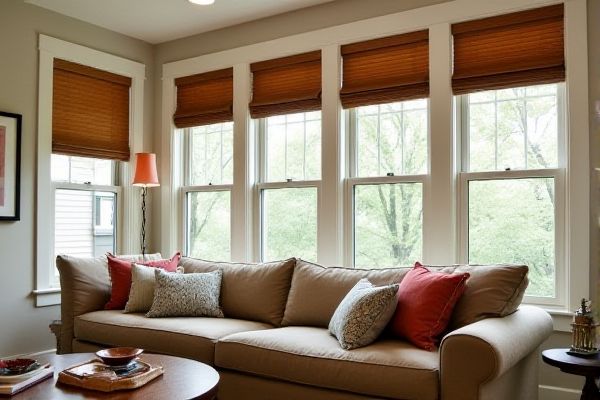
Wood blinds offer a natural, warm aesthetic ideal for classic or upscale sunroom designs, while faux wood blinds provide greater durability and moisture resistance, making them perfect for humid or sun-exposed environments. Discover which option best suits your sunroom's style and functionality needs by reading the rest of this article.
Table of Comparison
| Feature | Wood Blinds | Faux Wood Blinds |
|---|---|---|
| Material | Natural hardwood | Composite wood and PVC |
| Durability | Less resistant to moisture and warping | Highly resistant to moisture, ideal for sunrooms |
| Appearance | Authentic wood grain and warm look | Wood-like finish, slightly synthetic appearance |
| Maintenance | Requires regular dusting and careful cleaning | Easy to clean with damp cloth, low maintenance |
| Cost | Higher initial investment | More affordable, cost-effective option |
| Sunroom Suitability | Prone to damage from sun and humidity | Designed to withstand sunroom conditions |
Introduction to Sunroom Window Treatments
Sunroom window treatments like wood blinds and faux wood blinds offer both aesthetic appeal and functional benefits, including light control and privacy. Wood blinds provide a natural, warm look with genuine wood grain, while faux wood blinds are moisture-resistant and more durable, making them ideal for humid sunroom environments. Choosing the right blinds enhances your sunroom's comfort and style while protecting your furnishings from UV damage.
Understanding Wood Blinds
Wood blinds provide natural warmth and elegance with genuine wood slats, enhancing sunroom aesthetics while offering moderate moisture resistance. Faux wood blinds, made from composite materials or PVC, mimic real wood's look but excel in durability and are more resistant to humidity and warping, making them ideal for sunrooms prone to moisture. Choosing between wood and faux wood blinds in a sunroom hinges on balancing authentic appearance with practical performance against environmental factors.
Exploring Faux Wood Blinds
Faux wood blinds provide exceptional durability and moisture resistance, making them ideal for sunroom environments where humidity and sunlight exposure are high. These blinds mimic the natural look of wood with enhanced UV protection and easy maintenance, ensuring they retain their appearance over time. Your sunroom benefits from faux wood blinds through their ability to withstand temperature fluctuations while offering timeless style and reliable functionality.
Aesthetic Appeal: Natural vs. Imitation
Wood blinds provide a warm, authentic appearance with unique grain patterns that enhance the natural ambiance of a sunroom. Faux wood blinds offer a consistent, uniform look that mimics natural wood while resisting moisture and fading, making them ideal for humid environments. The choice between natural wood and faux wood blinds balances genuine aesthetic appeal with practical durability tailored to sunroom conditions.
Durability in Sunrooms: Heat and Moisture Resistance
Faux wood blinds outperform natural wood blinds in sunrooms due to their superior resistance to heat and moisture, preventing warping, cracking, and discoloration. Made from PVC or composite materials, faux wood blinds maintain structural integrity and color stability even under intense sunlight and fluctuating humidity levels. Natural wood blinds, while aesthetically pleasing, require regular maintenance and are more susceptible to damage in sunroom environments with high heat and moisture.
Light Control and UV Protection
Wood blinds offer excellent light control with adjustable slats that allow precise regulation of sunlight entering a sunroom, while their natural material provides moderate UV protection. Faux wood blinds, made from durable composite materials, deliver superior UV resistance, preventing sun damage and fading in sunroom furnishings without sacrificing effective light control. Both options enhance sunroom comfort, but faux wood blinds are particularly advantageous for rooms with intense sun exposure due to their enhanced durability and UV shielding properties.
Energy Efficiency and Insulation
Wood blinds offer natural insulation due to the density of real wood fibers, helping to maintain indoor temperatures and reduce energy consumption in sunrooms. Faux wood blinds, made from PVC or composite materials, provide superior moisture resistance and comparable insulation, making them ideal for sunroom environments exposed to humidity. Both options effectively minimize heat transfer, but faux wood blinds tend to offer enhanced durability and energy efficiency in fluctuating temperature conditions.
Maintenance and Cleaning Requirements
Wood blinds in a sunroom require regular dusting and occasional polishing to prevent warping and maintain their natural finish, while faux wood blinds offer superior resistance to moisture and humidity, making them easier to clean with just a damp cloth. Your choice impacts long-term upkeep, as faux wood blinds withstand sun exposure without fading or cracking, reducing the need for frequent maintenance. Opting for faux wood blinds can save time on cleaning and provide durable performance in the sunroom environment.
Cost Comparison: Wood vs. Faux Wood Blinds
Wood blinds typically range from $50 to $150 per blind, offering natural aesthetics but higher maintenance costs due to sensitivity to moisture and sunlight in a sunroom. Faux wood blinds cost between $30 and $70 per blind, providing a budget-friendly, moisture-resistant alternative that mimics real wood without warping or fading. Considering durability and exposure conditions, faux wood blinds deliver better long-term value and cost-efficiency for sunroom environments.
Making the Best Choice for Your Sunroom
Wood blinds offer natural warmth and classic elegance, ideal for sunrooms seeking an authentic, cozy atmosphere. Faux wood blinds provide superior moisture resistance and durability, making them perfect for sunrooms exposed to fluctuating humidity and direct sunlight. Your decision should weigh wood's aesthetic appeal against faux wood's practicality to ensure lasting beauty and functionality.
 homyna.com
homyna.com